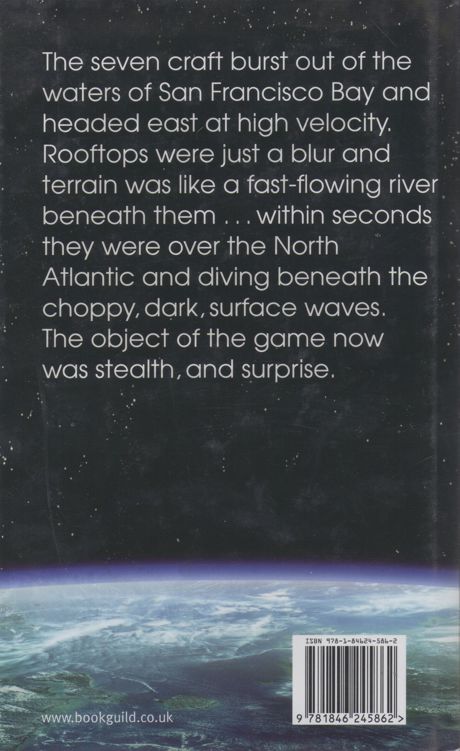Battle for the Earth
Read Battle for the Earth Online
Authors: John P. Gledhill


| Battle for the Earth |
| John P. Gledhill |

~ * ~
Battle for the Earth
John P. Gleedhill

No copyright  2013 by MadMaxAU eBooks
2013 by MadMaxAU eBooks
**
1
It starts December 20, 2020, 12.00 midnight GMT, D-Day for Earth, in total silence. At a height of three hundred miles above our blue planet, high in our thermosphere, twelve strategically placed EMP charges detonate simultaneously. They make very little noise or explosion, but the effects are no less than devastating for humanity. Each burst of EMP has been amplified and targeted to a specific one-twelfth segment of planet Earth, a bit like peeling an orange and splitting the segments.
EMP, Electro-Magnetic Pulse, travels more or less instantaneously. Anything powered by electricity or has wires, your mobile phone, microwave ovens, your television, computers, light bulbs, street lights, power lines, cars, your home, hospitals, police stations, power stations, your nation’s ability to defend you, burnt out and gone beyond repair, all in a heart-beat.
12.10 GMT, fifty miles above our blue planet, the start of space, twelve perfect orbs orbiting in unison begin to release in measured quantities their lethal payload, a fine dust of viral content, very similar in genetic code to the 1918 flu virus h1n1, which at the time killed up to one hundred million people worldwide.
The first victims to succumb to this lethal dust will be the birds flying high in our skies, inhaling the fine particles as gravity unwittingly distributes this horrendous virus worldwide. The virus’s ability to jump species will do the rest.
For an explanation of this extraordinary death sentence on mankind, we need to travel back in time, 12,000 years ago.
**
Near the Chinese and Tibetan border high in the mountains of BayanKara-Ula, a team of archaeologists were conducting a very detailed survey of a series of interlinked caves.
This team was lead by Professor Chi Pu Tei, an expert in his field. What they discovered within these caves were lines of neatly arranged graves which contained oddly shaped skeletons, large head, smallish body. As it was initially thought the caves were occupied by an unknown species of ape, this discovery was exceptionally unusual. Apes are not known to bury themselves.
It was while studying the skeletons that one of the team stumbled on a large, round stone disc, half buried in the dust on the floor of the cave. The best way to describe this object would be a prehistoric gramophone record. There was a hole in the centre and a fine spiral groove radiated to the rim.
**
Because this was 1938, and a troubled time on planet Earth, this discovery passed more or less unnoticed until a closer examination of the disc showed that the groove was, in fact, a continuous spiralling line of closely written characters. Many experts tried to translate the hieroglyphics in the twenty years the disc languished in Peking, but nobody succeeded.
On further study of the caves, a total of 716 of the grooved discs were uncovered. They became known as ‘The Dropas Stones’. By this time any conclusions by Professor Chi Pu Tei had been suppressed by the Peking Academy of Pre-History.
Eventually, in 1965, the professor and four of his colleagues were given permission to reveal their theory. It appeared under the longwinded but mysterious title, ‘The Grooved Script concerning Space-Ships which, as recorded on the Discs, crash-landed on Earth 12,000 years ago.’
**
Apparently, as history dictated, the two space craft were caught up in a horrendous storm: one of the craft suffered a direct lightning strike, which catapulted it into the other craft, downing both heavily, and beyond repair. These space ships and their inhabitants were the trigger for civilisation as we have known it over the years.
Over generations the visitors became known as the Dropas, and in build were not too dissimilar to ourselves -slightly smaller in height, larger cranium, greyish, smoother skin, reproductive organs - but worlds apart in intelligence. They were eventually accepted for their peaceful intentions by the surrounding tribe of the Ham, who were indigenous to that region. Integration, breeding and migration followed. The dice of civilisation were thrown and scattered to the four winds.
**
Over the next eight thousand years Man’s intelligence and knowledge steadily improved, to a time when the Sumerian Dynasty depicted, in around 4,000 BC, the Annunaki as travelling from the twelfth planet - ‘The Sumerians counted the sun and Earth’s moon as planets’ - 432,000 years ago to make slaves of Neanderthal man, and mine for gold.
Gold in its pure state is a critical tool for both the Dropas and the Annunaki, as it is used in its gaseous state for hyper-drives in space travel. It was also used in their filtration and atmospheric conditioning systems on Nibiru, the Annunaki-colonised planet in this galaxy. Then there were the obvious uses: electronics, along with crystals and moissanite used in power-pulse systems and weapons. However, the enslavement of this early species of primitive man proved far more difficult than had been imagined by the Annunaki, especially for the purpose of intense mining.
The solution provided by the Annunaki scientists was to splice the genes of Neanderthal man with the Annunaki gene, making a more intelligent Homo Sapiens, in the hope they could be trained more successfully. However, this was unsuccessful and only created a desire for uprising and new-found freedom: the ‘Missing Link’ had been born.
The Annunaki were banished after a successful uprising, leaving Homo Sapiens with enhanced intellect, aggression and a growing desire over the centuries for valuable precious metals.
**
2
The tenth planet, Nibiru, or planet X, was home to two warring factions, the Dropas - intelligent, technical, and good engineers - and the Annunaki - aggressive warriors.
Nibiru was first colonised by the Annunaki and the Dropas 750,000 years ago for the purpose of mining its valuable metals and minerals - gold, moissanite - and many more required for their technology. This required the annexing of a normally inhabitable planet. Advanced infrastructures capable of supporting life, and a habitat above and below the planet surface were created and mining began.
For the first 450,000 years things went smoothly, with mining and supply convoys going between Nibiru and the star system Sirius, the home star system of both the Annunaki and the Dropas.
Then the supply convoys slowed in regularity and eventually came to a stop, with rumours of a cataclysmic war and extinction in their home star system. The Dropas and the Annunaki found themselves bound together with a common goal: survival.
**
This led to an uneasy peace between the two for the next 200,000 years. Although Nibiru was now an extremely advanced society, space to live was becoming a premium and natural resources were all but mined out, a combination of events which would prove to be a recipe for disaster.
Eventually the inevitable war happened. Over the next decade the Dropas were routed from Nibiru and fled as a small group of survivors to seek refuge wherever they could. This happened to be a small blue planet called Earth, deep within the Mariana trench, where the Dropas set up home.
The Mariana trench was an ideal bolthole for the Dropas as it was five miles deep under the Pacific Ocean, and at its deepest point seven miles down, this point being known as the Challenger Deep.
From this sub-vantage point the Dropas were able, over 100,000 thousand years and generations of adaptation, to re-establish themselves as a civilisation, even to the extent of subtle integration with mankind.
This was, of course, at BayanKara-Ula, and later, more meaningfully, Atlantis.
On further visitations to Earth by the Annunaki, a surprising legacy was discovered. Mankind had grown over the centuries to value gold, and to mine and refine it for themselves.
A decision was made by the Annunaki high council, to observe the status quo for the time being, and set a date for the harvesting of all the gold man had been able to mine and refine. This was to be done in one swoop.
Fortunately for mankind, this information was obtained by the Dropas from a high-ranking Annunaki, who had been on a craft which had crashed into the south Pacific Ocean due to mechanical failure.
The interrogation of this high-ranking warrior took place using highly advanced mind-probing technology and was a mine of information for the Dropas. Once all the extracted information had been collated, it was clear to the Dropas that mankind faced extermination on 21 December 2020, the date pre-set to harvest Earth’s gold. This left the Dropas with a huge dilemma.
The Dropas had also been totally unaware of the Annunaki intervention with Neanderthal man, and the splicing of genes to create homo-sapian man. This would now involve the Dropas in a long-term study of mankind’s evolvement, and any permanent damage done to mankind’s genes.
The Dropas thought long and hard over this dilemma, and it was decided that over the progress of mankind’s development, specimens would need to be extracted for medical investigations. This would be done in the most benign way possible, using the Dropas’ mind-control and memory-replacement technology. This policy worked well with mankind up until the late twentieth century, when these episodes became known as ‘abductions’.
The abductions caused confusion between scientists and professors, leading to a general opinion that the Dropas, or ‘Greys’, as they had been labelled, were the bad guys of the galaxy. This, of course, was not the case.
